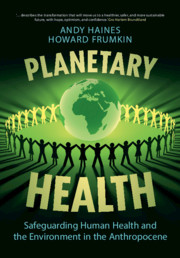Book contents
- Planetary Health
- Reviews
- Planetary Health
- Copyright page
- Contents
- Preface
- Acknowledgements
- 1 Our Changing Planet
- 2 Climate Change
- 3 Pollution, Land Use, Biodiversity, and Health
- 4 Assessing Vulnerability and Risk in the Anthropocene Epoch
- 5 Adaptation and Resilience to Planetary Change
- 6 Addressing Conceptual, Knowledge, and Implementation Challenges
- 7 Health in the Sustainable Development Goals
- 8 Transforming Energy and Industry: Towards a Net-Zero Circular Economy for Health
- 9 Sustaining Urban Health in the Anthropocene Epoch
- 10 Food Systems and Land Use
- 11 The Role of Health Professionals in Fostering Planetary Health
- 12 Sustaining Planetary Health in the Anthropocene
- Index
- References
6 - Addressing Conceptual, Knowledge, and Implementation Challenges
Published online by Cambridge University Press: 01 July 2021
- Planetary Health
- Reviews
- Planetary Health
- Copyright page
- Contents
- Preface
- Acknowledgements
- 1 Our Changing Planet
- 2 Climate Change
- 3 Pollution, Land Use, Biodiversity, and Health
- 4 Assessing Vulnerability and Risk in the Anthropocene Epoch
- 5 Adaptation and Resilience to Planetary Change
- 6 Addressing Conceptual, Knowledge, and Implementation Challenges
- 7 Health in the Sustainable Development Goals
- 8 Transforming Energy and Industry: Towards a Net-Zero Circular Economy for Health
- 9 Sustaining Urban Health in the Anthropocene Epoch
- 10 Food Systems and Land Use
- 11 The Role of Health Professionals in Fostering Planetary Health
- 12 Sustaining Planetary Health in the Anthropocene
- Index
- References
Summary
The Anthropocene Epoch offers both unprecedented challenges and opportunities for humanity. Which of those prevails will depend on decisions made at all levels, from global to individual, over coming years. There have been many warnings of the risks arising from our current myopic development pathways but the prospect of serious, and even catastrophic, effects may not motivate action on the scale and pace required; indeed it can result in feelings of impotence and resignation.
- Type
- Chapter
- Information
- Planetary HealthSafeguarding Human Health and the Environment in the Anthropocene, pp. 178 - 212Publisher: Cambridge University PressPrint publication year: 2021



